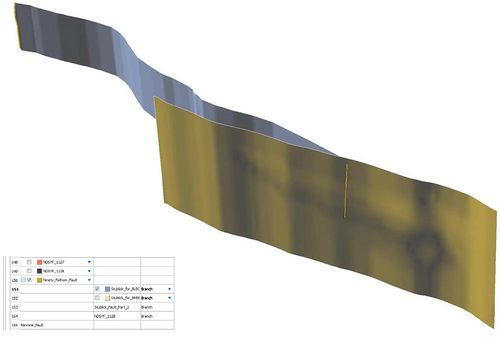OR/14/027 Software used: Difference between revisions
Jump to navigation
Jump to search
Created page with "__notoc__ {{OR/14/027}} ==Software used== * GOCAD® version 2.5.2 and GOCAD® v2009 * ArcGIS 9.3 * MS Excel ==Model workflow== The following workflow was used to generate the..." |
No edit summary |
||
| Line 12: | Line 12: | ||
# Additional data added included the NextMap DTM (See Model Datasets Section 4) | # Additional data added included the NextMap DTM (See Model Datasets Section 4) | ||
# A raw surface (uncut by faults at this stage) for each horizon was modelled using a combination of the structural contours and outcrop which had elevation values applied from the DTM surface data. | # A raw surface (uncut by faults at this stage) for each horizon was modelled using a combination of the structural contours and outcrop which had elevation values applied from the DTM surface data. | ||
# Every fault trace was draped onto its corresponding surface using the ‘Transfer Property by Vertical Projection’ tool and then following the methodology established in Sections 3.1 and 3.2, the fault plane was constructed. | # Every fault trace was draped onto its corresponding surface using the ‘Transfer Property by Vertical Projection’ tool and then following the methodology established in Sections 3.1 and 3.2, the fault plane was constructed. | ||
# Once all of the faults had been constructed, branch contacts were established between the faults using the manual ‘cut surfaces with constraints’ method. | # Once all of the faults had been constructed, branch contacts were established between the faults using the manual ‘cut surfaces with constraints’ method. | ||
# The faults were then used to cut the raw surface horizons using the ‘Horizon-Fault Contact Modelling’ in the Structural Modelling workflow. | # The faults were then used to cut the raw surface horizons using the ‘Horizon-Fault Contact Modelling’ in the Structural Modelling workflow. | ||
# Fault contacts and surface horizons were either edited using the Structural Modelling workflow parameters or manually using the tools available in GOCAD® | # Fault contacts and surface horizons were either edited using the Structural Modelling workflow parameters or manually using the tools available in GOCAD® | ||
Revision as of 16:34, 11 June 2015
| Hulbert A G, Terrington R L. 2015. Metadata report for the south-west Pennine Basin and adjacent area 1:250 000 resolution geological model. British Geological Survey Internal Report, OR/14/027. |
Software used
- GOCAD® version 2.5.2 and GOCAD® v2009
- ArcGIS 9.3
- MS Excel
Model workflow
The following workflow was used to generate the Northumberland-Solway Basin Model:
- Compiled all raw data into a GIS: W:\Teams\UKGF\RegionalLithoframe\Data\Cheshire_Staffs\ Cheshire_Staffs_v10.mxd
- Imported all fault traces, outcrop data and structural contours for each horizon into GOCAD®.
- Additional data added included the NextMap DTM (See Model Datasets Section 4)
- A raw surface (uncut by faults at this stage) for each horizon was modelled using a combination of the structural contours and outcrop which had elevation values applied from the DTM surface data.
- Every fault trace was draped onto its corresponding surface using the ‘Transfer Property by Vertical Projection’ tool and then following the methodology established in Sections 3.1 and 3.2, the fault plane was constructed.
- Once all of the faults had been constructed, branch contacts were established between the faults using the manual ‘cut surfaces with constraints’ method.
- The faults were then used to cut the raw surface horizons using the ‘Horizon-Fault Contact Modelling’ in the Structural Modelling workflow.
- Fault contacts and surface horizons were either edited using the Structural Modelling workflow parameters or manually using the tools available in GOCAD®
